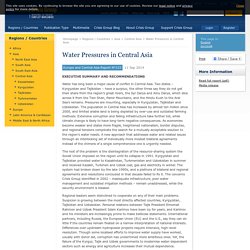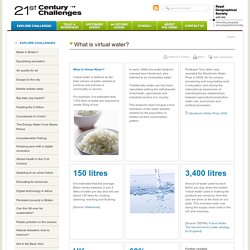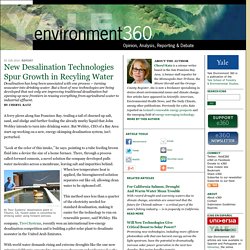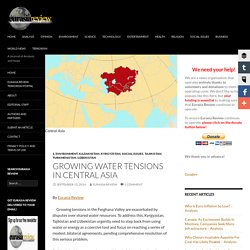

World's largest hydropower project planned for Tibetan Plateau. China and India 'water grab' dams put ecology of Himalayas in danger. The future of the world's most famous mountain range could be endangered by a vast dam-building project, as a risky regional race for water resources takes place in Asia.

New academic research shows that India, Nepal, Bhutan and Pakistan are engaged in a huge "water grab" in the Himalayas, as they seek new sources of electricity to power their economies. Taken together, the countries have plans for more than 400 hydro dams which, if built, could together provide more than 160,000MW of electricity – three times more than the UK uses. In addition, China has plans for around 100 dams to generate a similar amount of power from major rivers rising in Tibet. A further 60 or more dams are being planned for the Mekong river which also rises in Tibet and flows south through south-east Asia. Most of the Himalayan rivers have been relatively untouched by dams near their sources. Why India and China should leave the Yarlung Tsangpo alone. This is part of a special series of articles produced by our sister site thethirdpole.net on the future of the Yarlung Tsangpo river - one of the world's great transboundary rivers - which starts on the Tibetan Plateau before passing through India and Bangladesh.

Also read:- It's time for a new era of cooperation on the Yarlung Tsangpo - World's largest hydropower project planned for the Tibetan Plateau - Yarlung Tsangpo river is a living ecosytem, not just a source of hydropower In October 2012, Indians learned that China had begun to construct a 700 megawatt (MW) capacity dam on the Brahmaputra river (Yarlung Tsangpo). The news aroused fears that China intended not only to generate power from the river but also divert some of its waters to the arid northern regions of the country. This possibility was first mentioned at the international conference of the Global Infrastructure Fund in Anchorage, Alaska, in 1986. China’s Upstream Advantage in the Great Himalayan Watershed. Jennifer L.

Turner, Susan Chan Shifflett and Robert Batten Jennifer L. Turner is the Director of the China Environment Forum at the Woodrow Wilson International Center for Scholars in Washington, D.C. Susan Chan Shifflett is a Program Associate at the China Environment Forum at the Woodrow Wilson International Center for Scholars in Washington, D.C. Robert Batten is a Summer Research Assistant at the China Environment Forum at the Woodrow Wilson International Center for Scholars in Washington, D.C. The four-character Chinese idiom "benefiting from the gifts of nature" (de tian du hou) captures China’s riparian advantage in the great Himalayan watershed. Water Pressures in Central Asia. Europe and Central Asia Report N°233 11 Sep 2014 Water has long been a major cause of conflict in Central Asia.

Two states – Kyrgyzstan and Tajikistan – have a surplus; the other three say they do not get their share from the region’s great rivers, the Syr Darya and Amu Darya, which slice across it from the Tien Shan, Pamir Mountains, and the Hindu Kush to the Aral Sea’s remains. Pressures are mounting, especially in Kyrgyzstan, Tajikistan and Uzbekistan. The population in Central Asia has increased by almost ten million since 2000, and limited arable land is being depleted by over-use and outdated farming methods.
Extensive corruption and failing infrastructure take further toll, while climate change is likely to have long-term negative consequences. Central Asia′s intensifying water dispute. Water management in Central Asia has long been a controversial issue.

It is a region where major rivers cross international borders and water and energy production are closely intertwined. In 2012, a dispute over water resources risked provoking military conflict among the former Soviet republics, due to plans by Kyrgyzstan and Tajikistan to dam rivers for hydropower projects. Uzbekistan, Central Asia's most populous country, depends on the rivers that rise in these neighboring countries to irrigate farmland and it has long been opposed to plans to revive Soviet-era projects to build dams upstream. In a recently released report, the International Crisis Group (ICG) says that political rivalries, nationalism and mistrust have also been increasing tensions.
Mekong River at risk as Laos forges ahead with dam-building spree. The Challenge Program on Water and Food- (CPWF) Mekong dams database provides the locations of every known commissioned, under-construction and planned dam in the Mekong River Basin Construction of a giant controversial dam in Laos has been well underway since it began in late 2012.

Laos is also set to push ahead with a second hydropower dam on the Mekong River this year in the face of growing concerns among its neighbors. Opponents of these projects said their commencement would also kick off the construction of the 9 other dams planned by Laos on the lower reaches of the 4,900-kilometer (3,045-mile)-long Mekong, which is second only to the Amazon in terms of biodiversity. The river begins in the Tibetan plateau and flows through China, Myanmar, Thailand, Laos, Cambodia and Vietnam before emptying into the East Sea, internationally known as the South China Sea. “Words without actions are meaningless,” Trandem said. Business as usual Viraphonh shrugged off such concerns.
Tibet and 21st Century Water Wars. The crucial global role that Asia will play in the 21st century cannot be underestimated.

The pivot of global economic power is shifting east. Tibet and 21st Century Water Wars. Tibet and 21st Century Water Wars. Mekong River at risk as Laos forges ahead with dam-building spree. Why India and China should leave the Yarlung Tsangpo alone. What is virtual water? The world's 6th largest net importer of virtual water for agriculture. behind Brazil, Mexico, Japan, China and Italy.

[Source: WWF UK footprint report] Page. Virtual Water - Virtual Water - Water for our Future. New Desalination Technologies Spur Growth in Recyling Water by Cheryl Katz: Yale Environment 360. 03 Jun 2014: Report by cheryl katz A ferry plows along San Francisco Bay, trailing a tail of churned up salt, sand, and sludge and further fouling the already murky liquid that John Webley intends to turn into drinking water.

But Webley, CEO of a Bay Area start-up working on a new, energy-skimping desalination system, isn’t perturbed. “Look at the color of this intake,” he says, pointing to a tube feeding brown fluid into a device the size of a home furnace. There, through a process called forward osmosis, a novel solution the company developed pulls water molecules across a membrane, leaving salt and impurities behind. Cheryl Katz At Trevi Systems' desalination plant in Tiburon, CA, fouled water is converted to drinking water using forward osmosis. When low temperature heat is applied, the bioengineered solution separates out like oil, allowing clean water to be siphoned off.
New Desalination Technologies Spur Growth in Recyling Water by Cheryl Katz: Yale Environment 360. Www.unesco.org/new/fileadmin/MULTIMEDIA/HQ/SC/pdf/WWDR4 Volume 1-Managing Water under Uncertainty and Risk.pdf. International Decade for Action 'Water for Life' 2005-2015. Mapping The World's Water Conflicts Shows Trouble Ahead. Growing Water Tensions In Central Asia. By Eurasia Review Growing tensions in the Ferghana Valley are exacerbated by disputes over shared water resources.

To address this, Kyrgyzstan, Tajikistan and Uzbekistan urgently need to step back from using water or energy as a coercive tool and focus on reaching a series of modest, bilateral agreements, pending comprehensive resolution of this serious problem. Outlook on the Global Agenda 2015. Having been in the field, most recently in India, I have seen that access to safe water is just a few dollars away for many people. A small loan can create a pathway to a household water tap. Making access to capital ubiquitous and affordable for those living in poverty would go a long way towards eliminating water stress. Due to a combination of problems, including rapid population growth, constrained water supplies and high levels of poverty, countries such as India, Indonesia, Bangladesh and Nigeria will be hit the hardest by this trend.
Risk Science Center Mapping global risks and opportunities in 2015 - Risk Science Center. Over the next few days, I’ll be joining experts from around the world to address emerging global trends and challenges at the World Economic Forum Summit on the Global Agenda. Framing our discussions will be the just-released Outlook on the Global Agenda 2015 – a synthesis of leading expertise from around the world on some of the top issues facing global society over the next few years. Twin forces collide: Water scarcity and climate change - Government 2020. By 2025, 1.8 billion people live in regions with absolute water scarcity, and two-thirds of the world’s population is under water stress.* By 2020, the world needs a 13 percent increase in food production to meet the demand of 7.8 billion people, an addition of 890 million tons.** Urbanization, rising standards of living and associated consumerism puts increasing pressure on already scarce resources. Water is a Growing Source of Tension and Insecurity Across South Asia.
Water availability and use - Statistical Yearbook for Asia and the Pacific 2011. News.nationalgeographic.com/news/2014/01/140123-colorado-river-water-alfalfa-hay-farming-export-asia/ Water is a Growing Source of Tension and Insecurity Across South Asia. Asia's Next Challenge: Securing the Region's Water Future. Decreased access to a safe, stable water supply in Asia "will have a profound impact on security throughout the region," warns a new Asia Society Leadership Group report. Asia's Water Security Crisis: China, India, and the United States.
Elizabeth C. Economy PDF free through August 31, 2013. China says more than half of its groundwater is polluted. Water Wars. Right as the West is tightening the screws on Russia's energy sector, Vladimir Putin is accelerating his own pivot to the east, moving closer to another giant natural gas deal with China. Water is a Growing Source of Tension and Insecurity Across South Asia.
Growing Water Tensions In Central Asia. Water Politics » Growing Water Tensions In Central Asia. Will Water Scarcity Increase Tensions Across Asia? Asia’s Worsening Water Crisis. Brahma Chellaney Survival | vol. 54 no. 2 | April–May 2012 | pp. 143–156, DOI: 10.1080/00396338.2012.672806. Peak Water: The Rise and Fall of Cheap, Clean H2O. The Earth's surface is mostly water, yet across increasingly large swaths of the planet, H2O reservoirs are drying up.
Thirsty Asia 2: How Do We Respond to Peak Water? The real threat to our future is peak water. Peak oil has generated headlines in recent years, but the real threat to our future is peak water. There are substitutes for oil, but not for water. We can produce food without oil, but not without water.